You’ve probably always been curious, but never could (or wanted to) actually track how long it takes for a pile of dog waste to decompose in your backyard. Well luckily, we’re a company that is willing to deal with the stinkier end of dog ownership.
Following a freshly laid dog turd left out on my lawn, I photographed its appearance week by week until it completely broke down and could no longer be seen.
Follow this turd’s journey with us to learn what’s really going on during the breakdown process and find out “Just how long does it take dog waste to decompose?”
Want to skip the read and get the answer? Watch our 30 second video that sums it up.
Week 1
Size: 4 x 3.25”
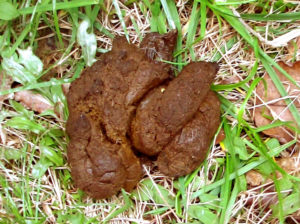 We’re starting off towards the end of March when the weather is finally warming up. A rich brown deposit is freshly laid on the lawn. Already, the waste contains a ton of pathogens that have exited through your dog’s digestive system. In fact, a single gram of dog waste contains an average of 23 million fecal coliform bacteria (close to twice the amount in human waste).
We’re starting off towards the end of March when the weather is finally warming up. A rich brown deposit is freshly laid on the lawn. Already, the waste contains a ton of pathogens that have exited through your dog’s digestive system. In fact, a single gram of dog waste contains an average of 23 million fecal coliform bacteria (close to twice the amount in human waste).
Now let’s talk parasites…
There are thousands of species of worms that can affect our pets, four of the most common being tapeworms, hookworms, whipworms, and roundworms. Whether your pup eats, drinks or even licks contaminated material, worm eggs can enter their body where the larvae grows into adult worms within the intestines. It will be a few weeks before these worms will start passing eggs into your dog’s stool.
Week 2
Size: 4 x 3.25”
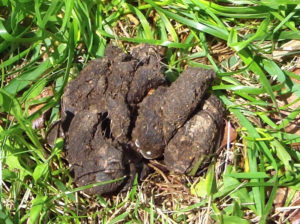 The waste looks similar, but shows early signs of decomposition. Microscopic bacteria goes to work to feed, reproduce, and break down the feces. While not all bacteria is dangerous, several bacterium may be lingering that can potentially cause an infection in both animals and humans by direct or indirect contact.
The waste looks similar, but shows early signs of decomposition. Microscopic bacteria goes to work to feed, reproduce, and break down the feces. While not all bacteria is dangerous, several bacterium may be lingering that can potentially cause an infection in both animals and humans by direct or indirect contact.
Like humans, dogs can carry a number of bacteria in their intestines and show no symptoms at all. But it is when these microorganisms (such as E coli, Salmonella, or Shigella) are accidentally consumed by mouth that it can cause severe diarrhea, vomiting… or worse.
Week 3
Size: 3.75 x 3.25”
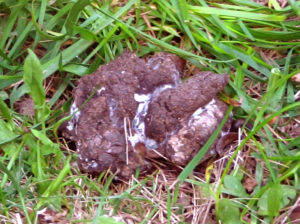 Mold is now visible on the surface of the dog waste – of course meaning more mold has been growing within. Dog feces is around 75% water, and serves as a perfect breeding ground for mold to thrive. Tiny mold spores are all around us, all the time, floating throughout the air. It is not until they find a damp organic material to land on, that they can feed, multiply and produce large enough masses for us to see.
Mold is now visible on the surface of the dog waste – of course meaning more mold has been growing within. Dog feces is around 75% water, and serves as a perfect breeding ground for mold to thrive. Tiny mold spores are all around us, all the time, floating throughout the air. It is not until they find a damp organic material to land on, that they can feed, multiply and produce large enough masses for us to see.
Week 4
Size: 3.5 x 3.25”
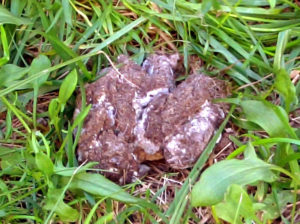 It is around now that the excreted parasitic eggs produce infective larvae, which will rest in a hard protective shell while waiting for a host. Eggs can remain viable for weeks to even years in the outdoor environment. All it takes is for you, your pet, or family member to come in contact with contaminated soil followed by contact with the mouth without washing your hands (or paws) and these eggs will travel right down the hatch. Once the larvae develops into adult worms, it can feed off the intestines for months to years, passing thousands of eggs into the feces every day; Thus continuing the cycle of intestinal parasite production in your backyard.
It is around now that the excreted parasitic eggs produce infective larvae, which will rest in a hard protective shell while waiting for a host. Eggs can remain viable for weeks to even years in the outdoor environment. All it takes is for you, your pet, or family member to come in contact with contaminated soil followed by contact with the mouth without washing your hands (or paws) and these eggs will travel right down the hatch. Once the larvae develops into adult worms, it can feed off the intestines for months to years, passing thousands of eggs into the feces every day; Thus continuing the cycle of intestinal parasite production in your backyard.
Before you go running your dog off the vet to be tested for every worm imaginable, know that worms are not always life threatening. In a healthy adult, and depending on the type of worm, it can simply cause an upset stomach and flu-like symptoms; But for those young, old, pregnant, or possess a weakened immune system can experience more serious issues.
Week 5
Size: 2.5 x 2.5”
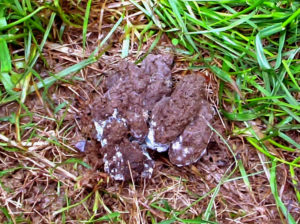 While the waste is being exposed to a mixture of weather conditions, the bacteria can move and spread through the air, soil and groundwater. A small gust of wind, or a short rainfall can transport pathogens like salmonella, hookworms, and giardia towards your home, an edible garden, or an unsuspecting neighbor; Nearby storm drains may collect the contaminated water runoff and send it out to our precious streams, lakes, and rivers.
While the waste is being exposed to a mixture of weather conditions, the bacteria can move and spread through the air, soil and groundwater. A small gust of wind, or a short rainfall can transport pathogens like salmonella, hookworms, and giardia towards your home, an edible garden, or an unsuspecting neighbor; Nearby storm drains may collect the contaminated water runoff and send it out to our precious streams, lakes, and rivers.
The longer the dog waste is left out, the greater the risk of the surrounding environment being negatively affected.
Week 6
Size: 2.25 x 2.5”
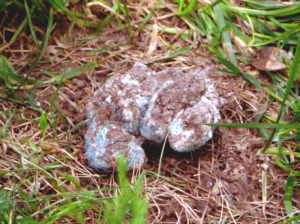 The mold has taken over. Being around these microscopic fungi can often trigger allergic reactions causing watery eyes, a runny nose and sneezing; Long term exposure can lead to painful inflammation and respiratory problems. Then there are a few more dangerous mold spores that can produce mycotoxins – poisonous substances that can cause illness, neurological issues, and disease. There is a much greater risk when dog waste is left to rot indoors, but a yard full of mold-filled feces can’t be good either.
The mold has taken over. Being around these microscopic fungi can often trigger allergic reactions causing watery eyes, a runny nose and sneezing; Long term exposure can lead to painful inflammation and respiratory problems. Then there are a few more dangerous mold spores that can produce mycotoxins – poisonous substances that can cause illness, neurological issues, and disease. There is a much greater risk when dog waste is left to rot indoors, but a yard full of mold-filled feces can’t be good either.
Week 7
Size: 2 x 2.5”
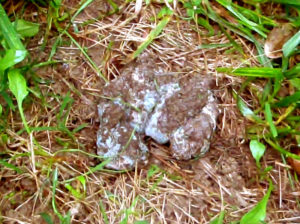 Although most contagions that stem from dog waste are not life threatening, they still can cause quite unpleasant symptoms after entering the body. If you are spending time outside on a lawn that has not been scooped by now, you, your pup and your family are at a greater risk of getting sick…. and your yard is at greater risk of becoming more contaminated.
Although most contagions that stem from dog waste are not life threatening, they still can cause quite unpleasant symptoms after entering the body. If you are spending time outside on a lawn that has not been scooped by now, you, your pup and your family are at a greater risk of getting sick…. and your yard is at greater risk of becoming more contaminated.
Did you know?
Roundworms in the intestines can pass an incredible 200,000 eggs per day into your dog’s feces! Their thick protective shell allows them to last up to two years in the soil as they wait for a nearby host (human or animal) to unwittingly ingest it. Roundworms can cause nausea, vomiting, and intestinal blockages.
Whipworms may only produce a few thousand eggs for your dog to excrete on a daily basis, but these eggs can last outside for an astonighly long time of seven years. If you or your pet happens to consume a whipworms egg, it can lead to diarrhea and fecal incontinence (and yes, your dog can be reinfected).
Hookworms may seem less threatening; While they can lay up to 30,000 eggs per day, they typically only last 1 month in the yard. But what may sound the alarms is that the most common way it finds a host is by penetrating the skin of a foot when one is walking on contaminated soil. Once infected, hookworms can cause weight loss, anemia, and terrible itchy rashes.
Learn more about certain bacteria and parasites that can exist in our beloved canine’s poo: https://www.petpooskiddoo.com/blog/the-lifecycle-of-intestinal-parasites/
Week 8
Size: 1.75 x 2”
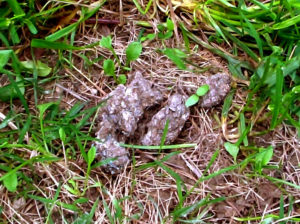 The waste has broken down so much that it is now in pieces. Bacteria and fungi have decomposed most of the organic matter with their enzymes, reducing it to carbon, nitrogen, and oxygen. Notice the bare grass in the shape of the pile’s original size. Fecal waste is so dense that it stops any sunlight from penetrating through, hence the grass underneath cannot perform its photosynthesis to survive.
The waste has broken down so much that it is now in pieces. Bacteria and fungi have decomposed most of the organic matter with their enzymes, reducing it to carbon, nitrogen, and oxygen. Notice the bare grass in the shape of the pile’s original size. Fecal waste is so dense that it stops any sunlight from penetrating through, hence the grass underneath cannot perform its photosynthesis to survive.
Week 9 (Final)
Size: Measurement :0”
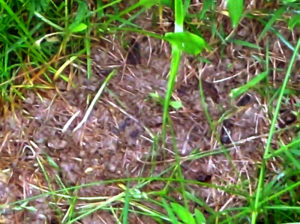 And just like that, it’s gone! It took a total of 9 weeks and there is no evidence left in sight – except for the bald spot. Just remember that even though the dog waste can no longer be seen, what is invisible to the eye can still linger on. We suggest to scoop no less than every two weeks before the eggs in the stool have time to become infectious. There is always going to be bacteria around you (especially when living with pets), but it’s important to do what you can to keep the bad bacteria at a minimum in order to to protect the health of both the environment as well as you and your family.
And just like that, it’s gone! It took a total of 9 weeks and there is no evidence left in sight – except for the bald spot. Just remember that even though the dog waste can no longer be seen, what is invisible to the eye can still linger on. We suggest to scoop no less than every two weeks before the eggs in the stool have time to become infectious. There is always going to be bacteria around you (especially when living with pets), but it’s important to do what you can to keep the bad bacteria at a minimum in order to to protect the health of both the environment as well as you and your family.
Doing the Math
If it takes 9 weeks for a single pile of dog poop to break down….
And dogs excrete an average of 0.75 lbs per day….
By the time the initial pile has fully decomposed,
an average size dog will have deposited 47.25 lbs into your backyard!
